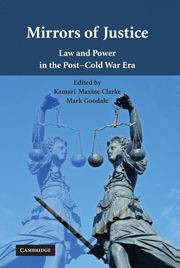Book contents
- Frontmatter
- Contents
- Editor Biographies
- Contributors
- Acknowledgments
- Introduction: Understanding the Multiplicity of Justice
- 1 Beyond Compliance: Toward an Anthropological Understanding of International Justice
- PART I JUSTICE AND THE GEOGRAPHIES OF INTERNATIONAL LAW
- PART II JUSTICE, POWER, AND NARRATIVES OF EVERYDAY LIFE
- PART III JUSTICE, MEMORY, AND THE POLITICS OF HISTORY
- Epilogue: The Words We Use: Justice, Human Rights, and the Sense of Injustice
- Index
- References
1 - Beyond Compliance: Toward an Anthropological Understanding of International Justice
Published online by Cambridge University Press: 25 January 2010
- Frontmatter
- Contents
- Editor Biographies
- Contributors
- Acknowledgments
- Introduction: Understanding the Multiplicity of Justice
- 1 Beyond Compliance: Toward an Anthropological Understanding of International Justice
- PART I JUSTICE AND THE GEOGRAPHIES OF INTERNATIONAL LAW
- PART II JUSTICE, POWER, AND NARRATIVES OF EVERYDAY LIFE
- PART III JUSTICE, MEMORY, AND THE POLITICS OF HISTORY
- Epilogue: The Words We Use: Justice, Human Rights, and the Sense of Injustice
- Index
- References
Summary
In this volume, Mark Goodale and Kamari Clarke courageously tackle the question of the meanings of justice in a world that is exploding with interest in human rights and transitional justice. These initiatives are powered by the idea of justice, and compliance is deeply dependent on the normative support that the evocation of justice provides. Yet, as they point out, justice is an extremely vague and unspecified concept, however powerful. Most people agree that they want justice but have far greater difficulty deciding which dictator of what country should be tried and whether he should be killed for which offenses. It is, as Goodale and Clarke say, the very aspirational quality and substantive openness of the concept of justice that gives it its power. In this regard, the idea of justice differs sharply from that of human rights, which has an elaborate set of legal texts and procedures such as conventions, treaty bodies, complaint mechanisms, and civil society organizations that ferret out abuses and translate them into human rights terms that are recognizable to these international institutions. Human rights specify relatively clearly what justice is and what procedures will produce it.
If we ponder the sources of ideas of justice, however, we realize that they are multiple and hardly all grounded in human rights. Responding to the challenge that Goodale and Clarke pose in the introduction, it seems that we are able to identify at least four discrete sources of justice ideas.
- Type
- Chapter
- Information
- Mirrors of JusticeLaw and Power in the Post-Cold War Era, pp. 28 - 42Publisher: Cambridge University PressPrint publication year: 2009
References
- 2
- Cited by



